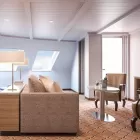Near the southern end of the Isle of Skye lies Loch Skarvaig. Open to the sea, the sheltered Loch penetrates the rounded granite hills of Skye. Heather moorlands grow on the hill slopes, with purple flowering heathers providing colour, starting in Spring and climaxing later in summer. Common Seals, otherwise known as Harbour Seals, are frequently seen swimming in the coastal water at high tides. Only their heads are visible as they take breaths between diving for a meal of fish, crustaceans or molluscs. At low tides the seals are easier to see, resting on the foreshore rocks. When ashore, Common Seals often lie on one side with their hind flippers and heads raised in a shallow U shape like oversized spotted grey bananas.
There are about 300 Common Seals living in and around Loch Coriusk. Skye also has a population of larger Grey Seals with long straight noses. Although all seals are protected now, they were once hunted for their skins, which were used to make clothes and for sporrans to accompany kilts. Considered the shortest river in Britain, Scavaig River or River Coruisk empties into Loch Scavaig. At only a few hundred metres long, it connects to the freshwater of Loch Coruisk. This freshwater loch collects run-off from the hills and overflows down the bends of the river to the sea of Loch Scavaig. Lying close together, the two lochs can look similar at high tide but they have totally different life. The saltwater kelps and shellfish of Loch Scavaig’s shores are revealed at low tide.
Many different groups of people have lived on the small Canna Isle. Neolithic people settled thousands of years ago. Later, Christian Celtic monks, Norse settlers and various Scottish groups lived on Canna. Evidence of most are still present, notably stone churches. One unusual relic is a standing stone with a hole above people’s heads in which the thumb of a lawbreaker was jammed. The accused was left for a time to reflect on his or her deeds. Canna is one of the Little Isles group of the Inner Hebrides. A bridge connects it to the adjacent Sanday Island. Both islands are small, with a tiny resident population. Today, the island is managed by the National Trust of Scotland. Compass Hill, 139 metres (456 feet) high, is a prominent landmark. It is named after the high iron content of the tuff—consolidated volcanic ash—makes up the hill. This attracted the needles of compasses on nearby ships causing confusion to pre-satellite navigators. The hill slopes have a variety of wildflowers that take advantage of good soils, and warm springs and summers. Canna is a bird sanctuary, with 15,000 breeding seabirds of 14 species. Half of the birds are Common Guillemots who nest on cliff ledges. A long-term National Trust bird ringing study has found guillemots live for a long time, with the oldest ever recorded for Britain being a 38 -year-old bird on Canne. As well as abundant seabirds, we may see scarcer birds including birds of prey. The majestic White-tailed Sea-eagle is one to look out for.











/140x140.webp)
/140x140.webp)
/140x140.webp)
/140x140.webp)
/140x140.webp)
/140x140.webp)
/140x140.webp)










